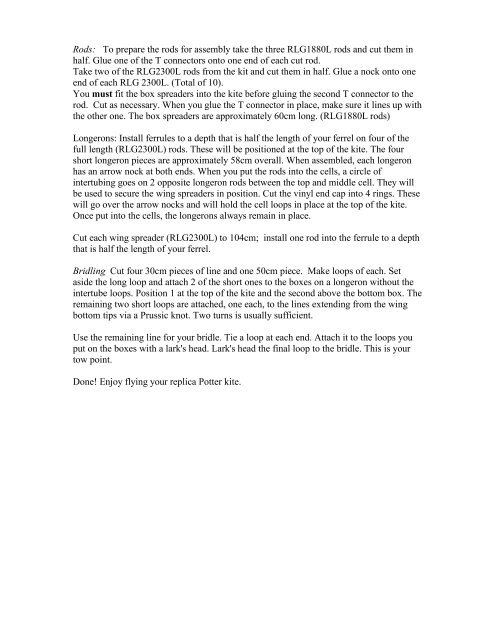Building instructions for the Potter Winged Box kite - 2kiters.com
Building instructions for the Potter Winged Box kite - 2kiters.com
Building instructions for the Potter Winged Box kite - 2kiters.com
Create successful ePaper yourself
Turn your PDF publications into a flip-book with our unique Google optimized e-Paper software.
Rods: To prepare <strong>the</strong> rods <strong>for</strong> assembly take <strong>the</strong> three RLG1880L rods and cut <strong>the</strong>m in<br />
half. Glue one of <strong>the</strong> T connectors onto one end of each cut rod.<br />
Take two of <strong>the</strong> RLG2300L rods from <strong>the</strong> kit and cut <strong>the</strong>m in half. Glue a nock onto one<br />
end of each RLG 2300L. (Total of 10).<br />
You must fit <strong>the</strong> box spreaders into <strong>the</strong> <strong>kite</strong> be<strong>for</strong>e gluing <strong>the</strong> second T connector to <strong>the</strong><br />
rod. Cut as necessary. When you glue <strong>the</strong> T connector in place, make sure it lines up with<br />
<strong>the</strong> o<strong>the</strong>r one. The box spreaders are approximately 60cm long. (RLG1880L rods)<br />
Longerons: Install ferrules to a depth that is half <strong>the</strong> length of your ferrel on four of <strong>the</strong><br />
full length (RLG2300L) rods. These will be positioned at <strong>the</strong> top of <strong>the</strong> <strong>kite</strong>. The four<br />
short longeron pieces are approximately 58cm overall. When assembled, each longeron<br />
has an arrow nock at both ends. When you put <strong>the</strong> rods into <strong>the</strong> cells, a circle of<br />
intertubing goes on 2 opposite longeron rods between <strong>the</strong> top and middle cell. They will<br />
be used to secure <strong>the</strong> wing spreaders in position. Cut <strong>the</strong> vinyl end cap into 4 rings. These<br />
will go over <strong>the</strong> arrow nocks and will hold <strong>the</strong> cell loops in place at <strong>the</strong> top of <strong>the</strong> <strong>kite</strong>.<br />
Once put into <strong>the</strong> cells, <strong>the</strong> longerons always remain in place.<br />
Cut each wing spreader (RLG2300L) to 104cm; install one rod into <strong>the</strong> ferrule to a depth<br />
that is half <strong>the</strong> length of your ferrel.<br />
Bridling Cut four 30cm pieces of line and one 50cm piece. Make loops of each. Set<br />
aside <strong>the</strong> long loop and attach 2 of <strong>the</strong> short ones to <strong>the</strong> boxes on a longeron without <strong>the</strong><br />
intertube loops. Position 1 at <strong>the</strong> top of <strong>the</strong> <strong>kite</strong> and <strong>the</strong> second above <strong>the</strong> bottom box. The<br />
remaining two short loops are attached, one each, to <strong>the</strong> lines extending from <strong>the</strong> wing<br />
bottom tips via a Prussic knot. Two turns is usually sufficient.<br />
Use <strong>the</strong> remaining line <strong>for</strong> your bridle. Tie a loop at each end. Attach it to <strong>the</strong> loops you<br />
put on <strong>the</strong> boxes with a lark's head. Lark's head <strong>the</strong> final loop to <strong>the</strong> bridle. This is your<br />
tow point.<br />
Done! Enjoy flying your replica <strong>Potter</strong> <strong>kite</strong>.


